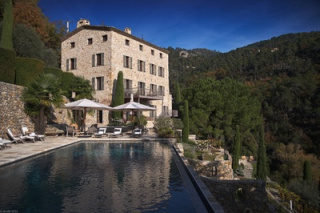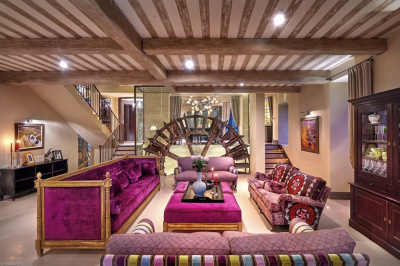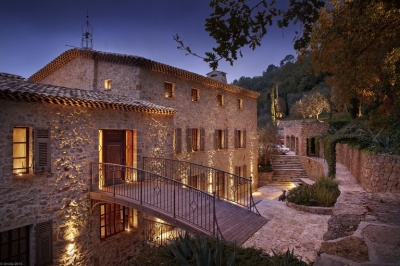Sotheby's International Realty
- 74 boulevard de la Croisette
- 06400 CANNES, France
- +33 4 92 92 12 88
Sotheby's International Realty
- 37 boulevard Marinoni
- 06310 BEAULIEU SUR MER, France
- +33 4 92 92 12 88
Sotheby's International Realty
- 3 avenue Denis Semeria
- 06230 SAINT JEAN CAP FERRAT, France
- +33 4 92 92 12 88
Sotheby's International Realty
- 9 avenue Paul Roussel
- 83990 SAINT TROPEZ, France
- +33 4 92 92 12 88
Sotheby's International Realty
- 5 rue Longchamp
- 06000 NICE, France
- +33 4 92 92 12 88
- Home
- >
- Luxury real estate
- >
- Les Moulins du Villars à Gilette : An architectural wonder nestled on the French Riviera
Les Moulins du Villars à Gilette : An architectural wonder nestled on the French Riviera

Côte d'Azur Sotheby's International Realty - The Private Desk is proud to offer you an exceptional estate on the French Riviera: Les Moulins du Villars, a prestigious property made up of a group of oil and flour mills, located in the village of Gilette, a small typical Provençal town on the French Riviera.
These mills have a long history dating back to the 17th century, and their unique architecture makes them a historical gem of the region.
The Moulins du Villars estate was built using the natural rocks of the region, giving it a raw, rustic mineral look. The estate is located on the banks of the Latti River, which once powered the mills' water wheels.
While the mills once produced flour and oil, the estate was transformed into a luxurious residence and welcomed high society from the late 1970s. Subsequently, in 2010, the property was completely transformed into what it is today, a haven of peace and quintessential discretion and privacy.
The elegant, typically Provençal property is nestled in the heights while remaining close to international social life with Nice Côte d'Azur international airport only 30 minutes away by car and 40 minutes from Monaco.
The amazing history of this property
Les Moulins du Villars is a property closely linked to the history of its region. Between the virtues of its spring and its connection to Princess Grace Kelly, it arouses infatuation and attention.
A spring that gives rhythm to the life of the property
The Villars Spring has been an important site for thousands of years. Its spring emerges from the base of an impressive yellow limestone cliff and irrigates the entire garden. Ancestral beliefs attribute druidic virtues to this water which is said to be curative.
A carefully chosen location
If today the location of the mills is synonymous with tranquility, isolation and calm, there was a time when this location meant the opposite.
Indeed, if it was chosen to build this set of mills at this place, it is because at the time the main road passed there: the only road connecting Nice to Digne and to the Haute Provence. Until the construction of the road through the gorges of the Var valley at the end of the 19th century, all traffic passed through Gilette and Le Villars. What is now a pleasure trail through the property was once one of the busiest mule trails in the region.
The era of the mills
The mill - now the main villa - has been rebuilt several times since Roman times. The oldest part of the present building was built in the 14th century; the most recent part was rebuilt in the 18th century. This mill would have been one of the largest industrial buildings in the area, with storage facilities, mule stables and an inn.
During the last centuries, the mill processed all types of crops depending on the season, but it was best known as an olive oil mill.
The original wrought iron mill wheel was one of the largest in France, but was too damaged to be restored. It was replaced in 2012 with a smaller wheel than the original, and the stone walls surrounding it were removed and replaced with a glass installation. The latter creates a link between the living room and the kitchen-dining room to form a very large reception area and allows the stream to flow through the living room: an atypical and quite astonishing detail, a true enhancement of the environment and history of this luxury home.
Buildings that are becoming obsolete
In the 1890s, a new road was built in the Esteron valley and moved the mills away from the trade routes. The arrival of electricity and the construction of electric mills in the town and in the valley finally sealed the fate of the mills.
In 1911, the Giraudy family, until then owner of the estate, decided to take advantage of the dominant position of the mills to make an advertising space visible from the road below and thus generate a profit from this estate which was no longer functioning as an agricultural production.
A new beginning
For most of the 20th century, all the buildings that make up Les Moulins du Villars today remained in ruins.
In 1970, the mill changed owners. Count Jean Fernand Joseph Gouin de Roumilly was attracted by the reputation of the Villars as a place of high energy and bought it with his associates as well as the twenty or so parcels of land surrounding the mill and rebuilt it.
Les Moulins du Villars (or Les Moulins du Capricorne, as it was then called) became famous among the French-speaking aristocracy of the Côte d'Azur for its extravagant social events, especially since Princess Grace Kelly befriended the owners and began staying there regularly.
The Princess of Monaco in Villars
One of her first visits was on June 21, 1980, accompanied by her daughter, Princess Caroline, and Prince Louis de Polignac, godfather of Albert II. This visit was formal with presentations of locally made cheeses and the olive oil for which Gilette is famous, as well as a performance by the Gilette choir.
The Princess must have been charmed by the Les Moulins du Villars property and its famous spring, for after that first visit, she returned alone on several occasions and, over time, gave several gifts to the house, including a number of statues. Two of them are still present. It is said that the Princess of Monaco considered the place very special and a rare haven of peace.
Enterprising new owners
The property changed hands in the early 1990s. The new owner, a Dutch entrepreneur, spared no effort or expense to transform the gardens into a natural splendor befitting the spectacular location. He employed a team of stonemasons who worked for 10 years to rebuild all the miles of natural stone walls on the property and channel all the streams.
The current owners purchased the property in 2006 as a summer home and quickly decided they wanted to spend time there year-round. So in 2010, they undertook a complete reconstruction of the main villa, with only the exterior walls of the original reconstruction remaining.
Although the house has survived centuries without incident, the city planning authorities insisted that it now be protected against earthquakes.
Thus, the building has new foundations and a reinforced concrete caisson inside the original 80 cm thick stone walls. In the process, each of the more than 40 window openings was enlarged to allow light into the living spaces.
The property
Recently restored, decorated and furnished to the highest standard by renowned Cap Ferrat architects, the Moulins property offers a peaceful haven in the heart of a nature reserve.


Interior and exterior of the main building with the mill wheel in its glass installation.
The main villa
The main villa is located in this beautiful garden: an old olive oil mill dating back to the 14th century, entirely rebuilt in 2012. The Sanctuary, the Cabanon, the India suite and the outbuildings are added to the property.
The outbuildings and high quality services
The Sanctuary, an ancient ruin dating from Roman times, was a former flour mill and industrial forge. It is now fully restored and used for events, and is surrounded by ancient ornamental fish ponds.
Added to this is the Cabanon, a charming guest house, and the private India suite located next to the pool, which offers luxury accommodation in a Rajastani atmosphere.
The property is fully equipped with high-end amenities and offers an infinity pool, gym, tennis court and helicopter landing pad (helipad). The high quality renovation is the result of the work of many specialists from all over France.
Indeed, if the building retains the exterior aspect of a traditional Mas, the renovation brings it the technology and comfort of the 21st century. The main building is equipped with underfloor heating, almost all the woodwork is in solid oak, the radiators are in old cast iron, all the windows - double glazed - are handmade in steel and incorporate electric screens. The ironwork is hand-forged by Joël Orgiazzi in Lyon, the mill wheel is hand-made by Alain Proust in the Loire, the mosaics are by Colleen Meyburg in Harare and the murals are by Philippe Roessler and Jane Skovgard. All of the stones on the building's facades were hand-cut on site and were taken from ancient blocks excavated from the ground for the new foundations.
The garden
On a 2.1 hectare amphitheater-shaped, south-facing plot of land, 16 grass terraces are laid out at an altitude of 470 m. They are partially planted with trees and shrubs. They are partially planted with fruit trees and beautiful olive trees that produce organic extra virgin olive oil.
The property is crossed by a stream that feeds the garden, its trees and its two vegetable gardens. This stream comes from the Villars Spring which gushes out of the cliff next to the main villa.
A town with a rich history
Gilette is a real strategic site, at the confluence of the Var and the Estéron, in a dominant position and with a panoramic view, which explains its history and its architecture.
Indeed the castle, built by Alphonse 1st, Count of Provence, was erected in the 13th century to watch over the Gilettois and the surrounding lands. Because of its dominant and almost inaccessible position, the castle became a stronghold and many battles marked the village during the 18th century between the soldiers of the Republic and the Austro-Sardinians, in particular the famous "Battle of Gilette" of October 18, 1793, inscribed on the Arc de Triomphe in Paris and represented on a painting by Roehn in the Versailles museum.
Today one can enjoy walks in the old village as well as the nearby Esteron Gorge which hosts the small paradise of the "Pont de la Cerise", an intimate spot known by the locals where small pools of fresh and clear water cascade. At the crossroads between Nice and Monaco, Gilette is a true jewel of the Maritime Alps, and is the ideal place to combine a peaceful and private life with the glamour and opportunities that the French Riviera offers.
Call on your experts in the hinterland of Nice and around Monaco for your real estate projects in the area and contact us:
info@cotedazur-sothebysrealty.com




